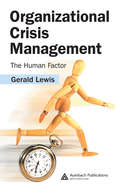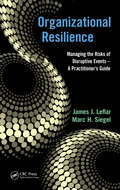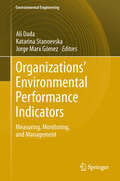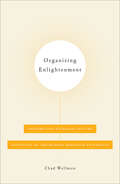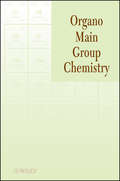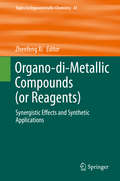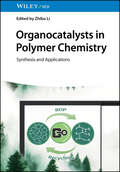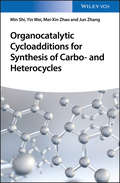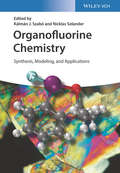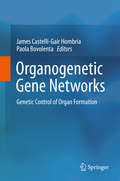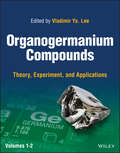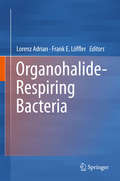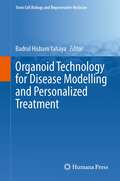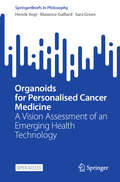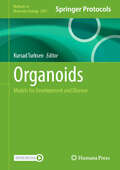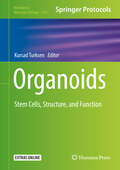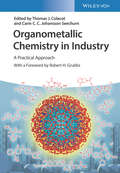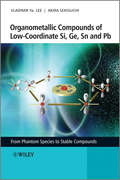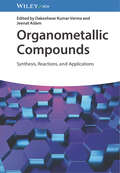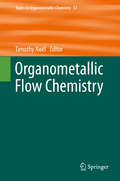- Table View
- List View
Organizational Behavior: Bridging Science and Practice Version 4.0
by Talya Bauer Berrin ErdoganThis textbook incorporates effective ways to bridge the gap between the theory and practice of management with the distinct, experiential, and evidence-based approach for which this book is known. Organizational Behavior provides the most timely and relevant concepts, vocabulary, frameworks, and critical-thinking skills necessary to diagnose situations, ask tough questions, evaluate answers received, and act in an effective and ethical manner taking into consideration the specific situational characteristics.
Organizational Crisis Management: The Human Factor
by Gerald LewisOrganizational Crisis Management: The Human Factor offers theoretical background and practical strategies for responding to workplace crises. Responding to a paradigm that focuses on the operational aspects of continuity to the detriment of human factors, this volume provides a comprehensive understanding of the unavoidable yet often complex reacti
Organizational Learning at NASA: The Challenger and the Columbia Accidents
by Julianne Mahler Maureen Hogan CasamayouJust after 9:00 a. m. on February 1, 2003, the space shuttle Columbia broke apart and was lost over Texas. This tragic event led, as the Challenger accident had 17 years earlier, to an intensive government investigation of the technological and organizational causes of the accident. The investigation found chilling similarities between the two accidents, leading the Columbia Accident Investigation Board to conclude that NASA failed to learn from its earlier tragedy. Despite the frequency with which organizations are encouraged to adopt learning practices, organizational learning--especially in public organizations--is not well understood and deserves to be studied in more detail. This book fills that gap with a thorough examination of NASA's loss of the two shuttles. After offering an account of the processes that constitute organizational learning, Julianne G. Mahler focuses on what NASA did to address problems revealed by Challenger and its uneven efforts to institutionalize its own findings. She also suggests factors overlooked by both accident commissions and proposes broadly applicable hypotheses about learning in public organizations.
Organizational Resilience: Managing the Risks of Disruptive Events - A Practitioner's Guide
by Marc H. Siegel James J. LeflarMoving towards resiliency is more than just implanting policy and procedure; it is a process that takes organizations on a winding path requiring patience and tolerance. A good deal of learning will have to take place during the trip and that is why it is necessary to have patience and tolerate the learning process. Organizational Resilience: Manag
Organizations’ Environmental Performance Indicators
by Jorge Marx Gómez Ali Dada Katarina StanoevskaThe book provides a collection of individual chapters from the participants in the OEPI project, which represent a mix of academic and practical chapters and contributions. The first part of the book is dedicated to a theoretical introduction to Organisations' Environmental Performance Indicators and to a state-of-the-art overview in literature and practice. The second part of the book contains several chapters describing information systems and their components supporting the management of Environmental Performance Indicators, especially in inter-organizational contexts. The third part is dedicated to three case studies from practice, and the book concludes with part four, in which practical guidelines for the innovative management of Environmental Performance indicators in organizations and in inter-organizational contexts are presented.
Organize Your Digital Life: How to Store Your Photographs, Music, Videos, and Personal Documents in a Digital World
by Aimee BaldridgeThis book delivers basic step-by-step instruction on streamlining and organizing your digital life, so you can find what you need instantly and create presentations your friends and family will love.
Organizing Enlightenment: Information Overload and the Invention of the Modern Research University
by Chad WellmonThe Enlightenment-era concerns that gave rise to the modern research university can illuminate contemporary debates about knowledge in the digital age.Since its inception, the research university has been the central institution of knowledge in the West. Today its intellectual authority is being challenged on many fronts, above all by radical technological change. Organizing Enlightenment tells the story of how the university emerged in the early nineteenth century at a similarly fraught moment of cultural anxiety about revolutionary technologies and their disruptive effects on established institutions of knowledge.Drawing on the histories of science, the university, and print, as well as media theory and philosophy, Chad Wellmon explains how the research university and the ethic of disciplinarity it created emerged as the final and most lasting technology of the Enlightenment. Organizing Enlightenment reveals higher education’s story as one not only of the production of knowledge but also of the formation of a particular type of person: the disciplinary self. In order to survive, the university would have to institutionalize a new order of knowledge, one that was self-organizing, internally coherent, and embodied in the very character of the modern, critical scholar.
Organo Main Group Chemistry
by Kin-ya AkibaForging a new association; main group elements and organic chemistry Covering the essentials of all main group elements in organic chemistry, along with the synthesis and reactions of their organic compounds in just one volume, Organo Main Group Chemistry breaks important new ground. While main group chemistry has traditionally been classified as part of inorganic chemistry, this book establishes the organic chemistry of main group elements for the first time. The organic compounds of elements in the second period of the periodic table, which are centered around carbon, are the major components of animals and plants, while those in the third period and below also play key roles worthy of discussion when studying main group element chemistry. The major chapters describe synthesis and reactivity of organic compounds in the third period and below and are arranged according to the order of the periodic table. Starting with the role of lithium and magnesium cations, the chapters reach fluorine and iodine compounds. The first two chapters summarize the unique and common characteristics of main group elements in relation to carbon. The latter chapters deal with modern topics that address the unique characteristics of organo main group compounds. Suitable for professional researchers, chemistry professors, and advanced students, Organo Main Group Chemistry presents a novel new approach to the way we view both main groups and organic chemistry itself.
Organo-di-Metallic Compounds (or Reagents)
by Zhenfeng XiThe series Topics in Organometallic Chemistry presents critical overviews of research results in organometallic chemistry. As our understanding of organometallic structure, properties and mechanisms increases, new ways are opened for the design of organometallic compounds and reactions tailored to the needs of such diverse areas as organic synthesis, medical research, biology and materials science. Thus the scope of coverage includes a broad range of topics in pure and applied organometallic chemistry, where new breakthroughs are being achieved that are of significance to a larger scientific audience. The individual volumes of Topics in Organometallic Chemistry are thematic. Review articles are generally invited by the volume editors.
Organocatalysis
by Hilmar Weinmann Benjamin List Stefan Jaroch Manfred ReetzThis book provides an excellent overview on state-of-the-art of modern organocatalysis. It presents the contributions from leading experts, with backgrounds in academia and industry, to an Ernst Schering Research Foundation Symposium held in April 2007. It will be of interest to those who want a general overview of the topic, but also to those who want to learn more about the state-of-the-art, current trends and perspectives in this highly dynamic field of research.
Organocatalysts in Polymer Chemistry: Synthesis and Applications
by Zhibo LiProvides an up-to-date overview of organocatalysis in polymer chemistry, covers recent innovations and specific methodologies Organocatalysis is revolutionizing polymer chemistry, offering a sustainable, cost-effective alternative to traditional metal-based catalysts. Organocatalysts in Polymer Chemistry: Synthesis and Applications presents a detailed summary of the development of organocatalysts and their transformative impact on polymer synthesis. Contributions by an international team of specialists present cutting-edge methodologies for creating precise macromolecular structures, covering a wide range of polymerization methods and practical applications. Edited by Professor Zhibo Li, an acknowledged expert in polymer chemistry, the book covers the use of organocatalysts in processes such as ring-opening polymerization, controlled radical polymerization, and polymer depolymerization. It offers vital insights into the synthesis of advanced, biodegradable, and metal-free materials, making it a valuable resource of both foundational knowledge and the latest research breakthroughs in polymer chemistry. Exploring the development, advantages, and applications of organocatalysts in polymer synthesis, this book: Presents advanced techniques for creating precise polymer architectures, including molecular weight, stereochemistry, and topology control Discusses applications of organocatalysts in ring-opening polymerization (ROP), controlled radical polymerization, and copolymerization techniques Highlights organocatalysis as a metal-free, cost-effective, and environmentally friendly alternative for polymer synthesis Examines the role of organocatalysts in recycling and depolymerizing commodity polymers such as PET and polycarbonate Addresses the synthesis of degradable polymers for biomedical, electronic, and environmental uses Summarizes advancements over the past two decades and explores emerging trends in polymer chemistry Organocatalysts in Polymer Chemistry is essential reading for postgraduate students, researchers, and industrial professionals in polymer chemistry, materials science, and sustainable catalysis. It is also an essential reference for catalytic chemists, organic chemists, and chemical engineers engaged in the synthesis and application of polymers.
Organocatalytic Cycloadditions for Synthesis of Carbo- and Heterocycles
by Jun Zhang Min Shi Yin Wei Mei-Xin ZhaoOrganocatalytic Cycloadditions for Synthesis of Carbo- and Heterocycles offers a clear explanationto thedevelopment of and the information on the latest research pertaining to zwitterion-oriented cycloadditions promoted by organoamines, organophosphines, N-heterocyclic carbenes. The authors—noted experts in the field—include a comprehensive review to the investigations of the reaction mechanisms and explore the synthesis of different products from the same starting materials. Filled with illustrative examples and designed to be accessible, the text shows how to control the chemo-, regio- and stereoselectivity and explains the further design of novel cycloaddition reactions catalyzed by organoamines and organophosphines based on zwitterion-oriented synthetic strategy.
Organofluorine Chemistry: Synthesis, Modeling, and Applications
by SzaboBy presenting novel methods for the efficient preparation of fluorinated compounds and their application in pharmaceutical and agrochemical chemistry as well as medicine, this is a valuable source of information for all researchers in academia and industry!
Organogels
by Jean-Michel GuenetThis book provides a physics-oriented introduction to organogels with a comparison to polymer thermoreversible gels whenever relevant. The past decade has seen the development of a wide variety of newly-synthesized molecules that can spontaneously self-assemble or crystallize from their organic or aqueous solutions to produce fibrillar networks, namely organogels, with potential applications in organic electronics, light harvesting, bio-imaging, non-linear optics, and the like. This compact volume presents a detailed outlook of these novel molecular systems with special emphasis upon their thermodynamics, morphology, molecular structure, and rheology. The definition of these complex systems is also tackled, as well as the role of the solvent. The text features numerous temperature-phase diagrams for a variety of organogels as well as illustrations of their structures at the microscopic, mesoscopic and macroscopic level. A review of some potential applications is provided including hybrid functional materials with polymers and with carbon nanotubes. Throughout, discussions of theoretical developments and experimental advances are written at a level suitable for beginning graduate students through practicing researchers.
Organogenetic Gene Networks
by James Castelli-Gair Hombría Paola BovolentaAll animals, including humans, derive from a single cell, which possesses all the genetic instructions needed to define how the animal will look like. However, during development, the millions of cells that derive from the zygote will only select part of this genetic information to give rise to the various organs of the body. The coordination of different cell behaviours during development results in the formation of specialized tissues and organs giving rise to highly adapted animals. This book provides an overview of how this diversification is achieved during organ formation and how it may have evolved. Conserved cellular processes are presented using examples from selected vertebrate and invertebrate species that illustrate how developmental biologists are solving the complex puzzle of organ formation. This volume is aimed to students, researchers and medical doctors alike who want to find a simple but rigorous introduction on how gene networks control organ formation.
Organogermanium Compounds: Theory, Experiment, and Applications, 2 Volumes
by Vladimir Ya. LeeOrganogermanium Compounds Understand the chemistry of organogermanium compounds with this thorough and cutting-edge reference Discovered comparatively late in the history of chemistry, germanium has become one of the most technology-critical elements in modern industry. Germanium and its inorganic and organic derivatives found widespread applications in fiber- and infrared-optics, electronics, polymerization catalysis, solar electric technology, nanotechnology, chemotherapy, and more. Organogermanium compounds containing carbon to germanium chemical bonds, have applications in microelectronics, medicinal and health industries, and beyond. Organogermanium Compounds: Theory, Experiment, and Applications, 2 Volume Set provides a comprehensive review of this class of compounds in two thorough volumes. It covers all modern aspects of these critically important compounds, including theoretical, synthetic, physico-chemical, and applied research. Reflecting the latest breakthroughs in this rapidly growing field, this book promises to serve as the high-level reference for those readers who are interested in organogermanium chemistry. Organogermanium Compounds readers will also find: 19 chapters produced by leading global experts Descriptions of pivotal historical achievements in organogermanium research Coverage of the latest computational, synthetic, and applied breakthroughs Organogermanium Compounds is a critical reference for researchers and professionals in a wide range of academic and industrial fields working with these fascinating compounds. This will also be helpful for university and college students, at both graduate and undergraduate levels.
Organohalide-Respiring Bacteria
by Lorenz Adrian Frank E. LöfflerThis book summarizes the current state of knowledge concerning bacteria that use halogenated organic compounds as respiratory electron acceptors. The discovery of organohalide-respiring bacteria has expanded the range of electron acceptors used for energy conservation, and serves as a prime example of how scientific discoveries are enabling innovative engineering solutions that have transformed remediation practice. Individual chapters provide in-depth background information on the discovery, isolation, phylogeny, biochemistry, genomic features, and ecology of individual organohalide-respiring genera, including Dehalococcoides, Dehalogenimonas, Dehalobacter, Desulfitobacterium and Sulfurospirillum, as well as organohalide-respiring members of the Deltaproteobacteria. The book introduces readers to the fascinating biology of organohalide-respiring bacteria, offering a valuable resource for students, engineers and practitioners alike.
Organoid Technology for Disease Modelling and Personalized Treatment (Stem Cell Biology and Regenerative Medicine #71)
by Badrul Hisham YahayaOrganoid Technology for Disease Modelling and Personalised Treatment provides a comprehensive overview of current knowledge of the organoid as a human-organ-in-a-dish, a powerful new technology for studying fundamental aspects of human organ development and disease progression in the search for drugs for personalised treatment. This preclinical tool is extensively being utilised as a model for studying human diseases in a dish, which is critical for accurate predictive modelling in precision medicine. The chapters in this book introduces readers to the numerous applications of organoids in various fields of study, as well as ethical considerations associated with organoids. In stem cell biology and regenerative medicine, where chimaera research, biomaterials for tissue vascularisation, gene-editing technologies, and their use in clinical procedures especially issues related to ethical concern over the use of human organoids have gotten much attention. Organoid Technology for Disease Modelling and Personalised Treatment is an excellent resource for in-depth research on one of the most interesting and significant topics in stem cell and regenerative medicine. This book's chapter collection covers a fresh viewpoint on organoid technology that scholars will require reading.
Organoids for Personalised Cancer Medicine: A Vision Assessment of an Emerging Health Technology (SpringerBriefs in Philosophy)
by Sara Green Henrik Vogt Maxence GaillardThis open access book builds on and updates work performed in the HYBRIDA project, funded by the EU to develop an ethical framework for organoid research. Organoids are three-dimensional stem cell constructs that mimic organs of the body or tumours. Patient-derived organoids are envisioned to be grown from individual patients&’ tumours and used to tailor the most effective and safest treatments in a new form of personalized medicine. This text offers a critical assessment of this vision from the perspective of philosophy of medicine. The authors present a tailored &“vision assessment&”, presented as examples of methodological development, and applied to objects. They first analyse and describe the vision of using organoids for personalized cancer medicine, then critically evaluate this vision and finally comment on ethical implications of the epistemological issues and how to handle them. The authors further draw on sources for empirical inquiries. This book presents an exercise in health technology assessment conducted by philosophers. Its core readership are philosophers of medicine and bioethicists interested in personalized medicine and stem cell research.
Organoids: Models for Development and Disease (Methods in Molecular Biology #2951)
by Kursad TurksenThis volume explores the generation and characterization of organoids from different tissues, as these structures allow us to investigate questions about cell commitment and differentiation. Whether pursuing cell development or the genesis or treatment of diseases, organoid research, through the methods and techniques in this collection, aims to provide scientists with a way to regenerate different tissues or organs in their original form and function. Written for the highly successful Methods in Molecular Biology series, chapters include introductions to their respective topics, lists of the necessary materials and reagents, step-by-step and readily reproducible laboratory protocols, and tips on troubleshooting and avoiding known pitfalls. Authoritative and practical, Organoids: Models for Development and Disease serves as an ideal guide for researchers investigating this vital area of study.
Organoids: Stem Cells, Structure, and Function (Methods in Molecular Biology #1576)
by Kursad TurksenThis detailed volume addresses the challenge of how to instruct stem/early progenitor cells to progress through appropriate steps to generate functional 3-dimensional organs, one of the outstanding issues in regenerative medicine. The field of organoids is geared towards defining and demonstrating the in vitro conditions that achieve this goal. Written for the highly successful Methods in Molecular Biology series, chapters include introductions to their respective topics, lists of the necessary materials and reagents, step-by-step, readily reproducible laboratory protocols, and tips on troubleshooting and avoiding known pitfalls. Comprehensive and cutting-edge, Organoids: Stem Cells, Structure, and Function serves as an aid to researchers working in this vital area of research.
Organometallic Chemistry in Industry: A Practical Approach
by Thomas ColacotShowcases the important role of organometallic chemistry in industrial applications and includes practical examples and case studies This comprehensive book takes a practical approach to how organometallic chemistry is being used in industrial applications. It uniquely offers numerous, real-world examples and case studies that aid working R&D researchers as well as Ph.D. and postdoc students preparing to ace interviews in order to enter the workforce. Edited by two world-leading and established industrial chemists, the book covers flow chemistry (catalytic and non-catalytic organometallic chemistry), various cross-coupling reactions (C-C, C-N, and C-B) in classical batch chemistry, conjugate addition reactions, metathesis, and C-H arylation and achiral hydrogenation reactions. Beginning with an overview of the many industrial milestones within the field over the years, Organometallic Chemistry in Industry: A Practical Approach provides chapters covering: the design, development, and execution of a continuous flow enabled API manufacturing route; continuous manufacturing as an enabling technology for low temperature organometallic chemistry; the development of a nickel-catalyzed enantioselective Mizoroki-Heck coupling; and the development of iron-catalyzed Kumada cross-coupling for the large scale production of Aliskiren intermediates. The book also examines aspects of homogeneous hydrogenation from industrial research; the latest industrial uses of olefin metathesis; and more. -Includes rare industrial case studies difficult to find in current literature -Helps readers successfully carry out their own reactions -Covers topics like flow chemistry, cross-coupling reactions, and dehydrative decarbonylation -Features a foreword by Nobel Laureate R. H. Grubbs -A perfect resource for every R&D researcher in industry -Useful for PhD students and postdocs: excellent preparation for a job interview Organometallic Chemistry in Industry: A Practical Approach is an excellent resource for all chemists, including those working in the pharmaceutical industry and organometallics.
Organometallic Compounds of Low-Coordinate Si, Ge, Sn and Pb
by Akira Sekiguchi Vladimir Ya. LeeUntil recently the low-coordinate compounds of the heavier elements of group 14 were known only as transient, unstable species which were difficult to isolate. However recent developments have led to the stabilisation of these compounds and today heavier group 14 element cations, radicals, anions, carbene analogues, alkene and alkyne analogues and aromatics have all been prepared as highly reactive, stable, fully characterizable and readily available organometallic reagents.Organometallic Compounds of Low-Coordinate Si, Ge, Sn and Pb describes the chemistry of this exciting new class of organometallics, with an emphasis on their major similarities and differences with the analogous species in organic chemistry. Topics covered include include the synthesis, structure, reactions and synthetic applications of :Si-, Ge-, Sn and Pb-centered cations, radicals and anionsheavy analogues of carbenes: silylenes, germylenes, stannylenes and plumbylenesheavy analogues of alkenes: disilenes, digermenes, distannenes, diplumbenesheavy analogues of alkynes: disilynes, digermynes, distannynes, diplumbynes, and their valence isomersheteronuclear derivatives: silenes, germenes, stannenes, silagermenes, silastannenes, germastannenesheavy analogues of alkenes of the type: >E14=E13-, >E14=E15-, >E14=E16 [where E13, E14, E15 and E16 are elements of the groups 13, 14, 15 and 16]cyclic compounds (three-, four-, five-, and six-membered rings)heavy analogues of 1,3-dienes, allenes and other cumulenesheavy analogues of aromatic compounds; including a comparison between organometallic and organic aromaticityOrganometallic Compounds of Low-Coordinate Si, Ge, Sn and Pb is an essential guide to this emerging class of organometallic reagents for researchers and students in main group, organometallic, synthetic and silicon chemistry
Organometallic Compounds: Synthesis, Reactions, and Applications
by Jeenat Aslam Dakeshwar Kumar VermaOrganometallic Compounds An up-to-date overview of the fundamentals, synthesis, and applications of organometallic compounds Organometallic Compounds: Synthesis, Reactions, and Applications delivers an accessible and robust introduction to the fundamentals of organometallic compounds, including their reactions, catalytic mechanisms, and modern applications, including carbon-dioxide fixation, reduction, gas adsorption and purification, drug delivery, renewable energy, and wastewater treatment. The book also covers toxicological and computational studies. The authors address the current challenges confronting researchers seeking to sustainably synthesize and process organometallic compounds and offer complete coverage on the most recent advancements in applications relating to the fields of environmental science, electronics, fossil fuels, and more. Readers will also find: Introduces to fundamentals, nomenclature, properties, and classification of organometallic compounds Discusses methods of synthesis of organometallic compounds Practical discussions of organometallic complexes of the lanthanoids and actinoids, as well as bio-organometallic chemistry Includes characterization techniques of organometallic compounds Perfect for organic, environmental, inorganic, water, and catalytic chemists, Organometallic Compounds: Synthesis, Reactions, and Applications will also benefit chemical engineers and industrial chemists.
Organometallic Flow Chemistry
by Timothy NoëlThe series Topics in Organometallic Chemistry presents critical overviews of research results in organometallic chemistry. As our understanding of organometallic structure, properties and mechanisms increases, new ways are opened for the design of organometallic compounds and reactions tailored to the needs of such diverse areas as organic synthesis, medical research, biology and materials science. Thus the scope of coverage includes a broad range of topics of pure and applied organometallic chemistry, where new breakthroughs are being achieved that are of significance to a larger scientific audience. The individual volumes of Topics in Organometallic Chemistry are thematic. Review articles are generally invited by the volume editors. All chapters from Topics in Organometallic Chemistry are published OnlineFirst with an individual DOI. In references, Topics in Organometallic Chemistry is abbreviated as Top Organomet Chem and cited as a journal

